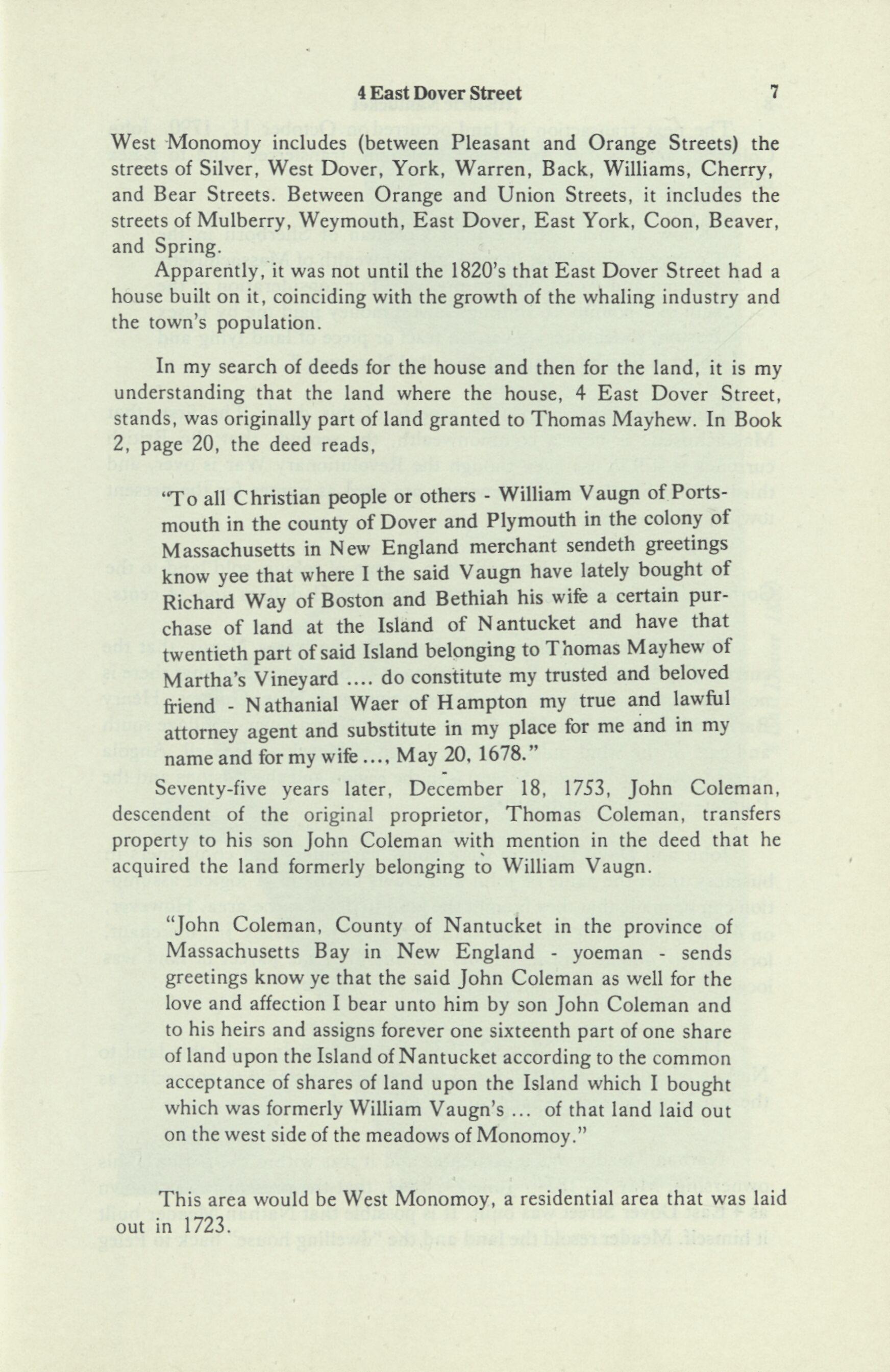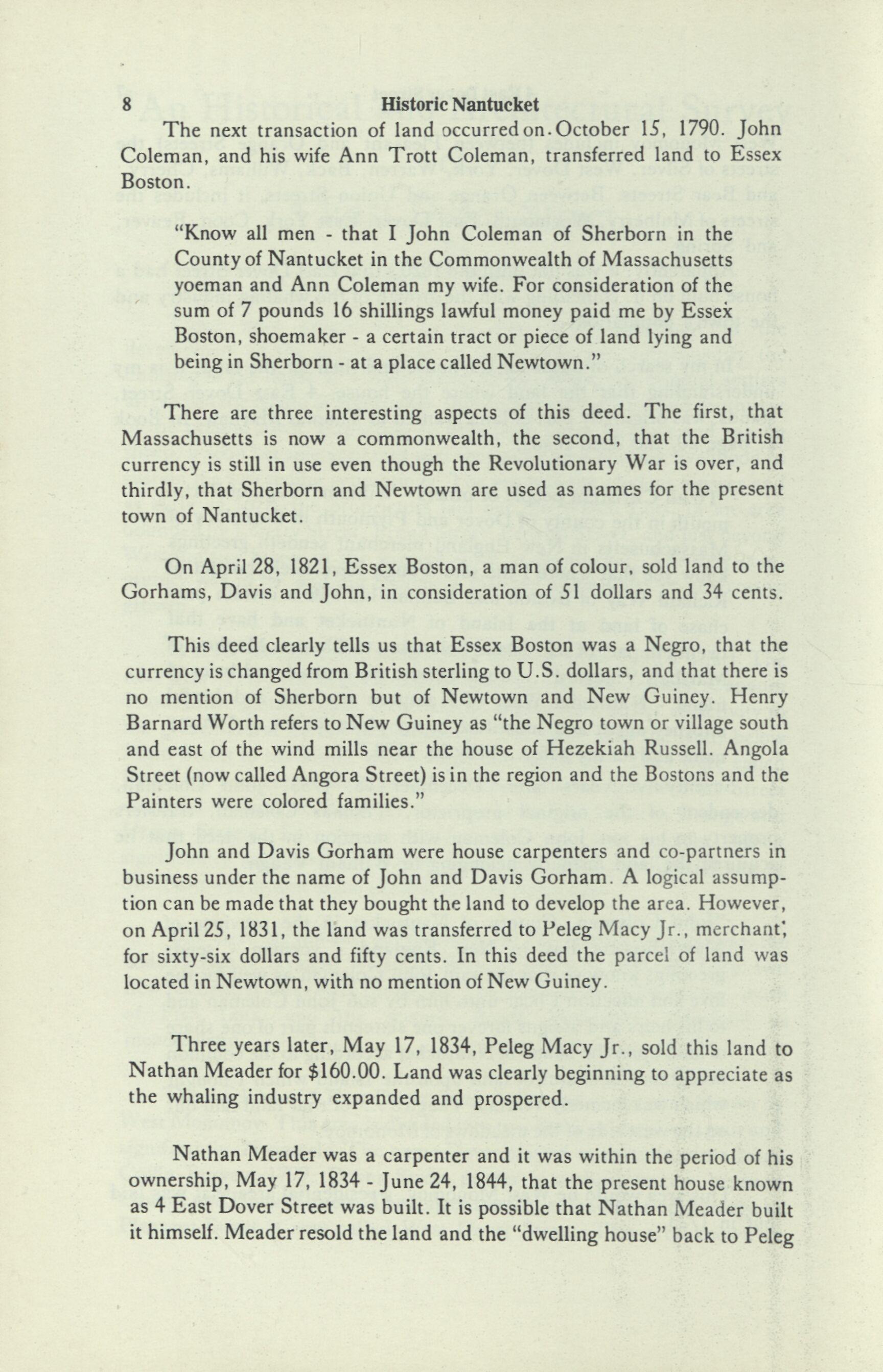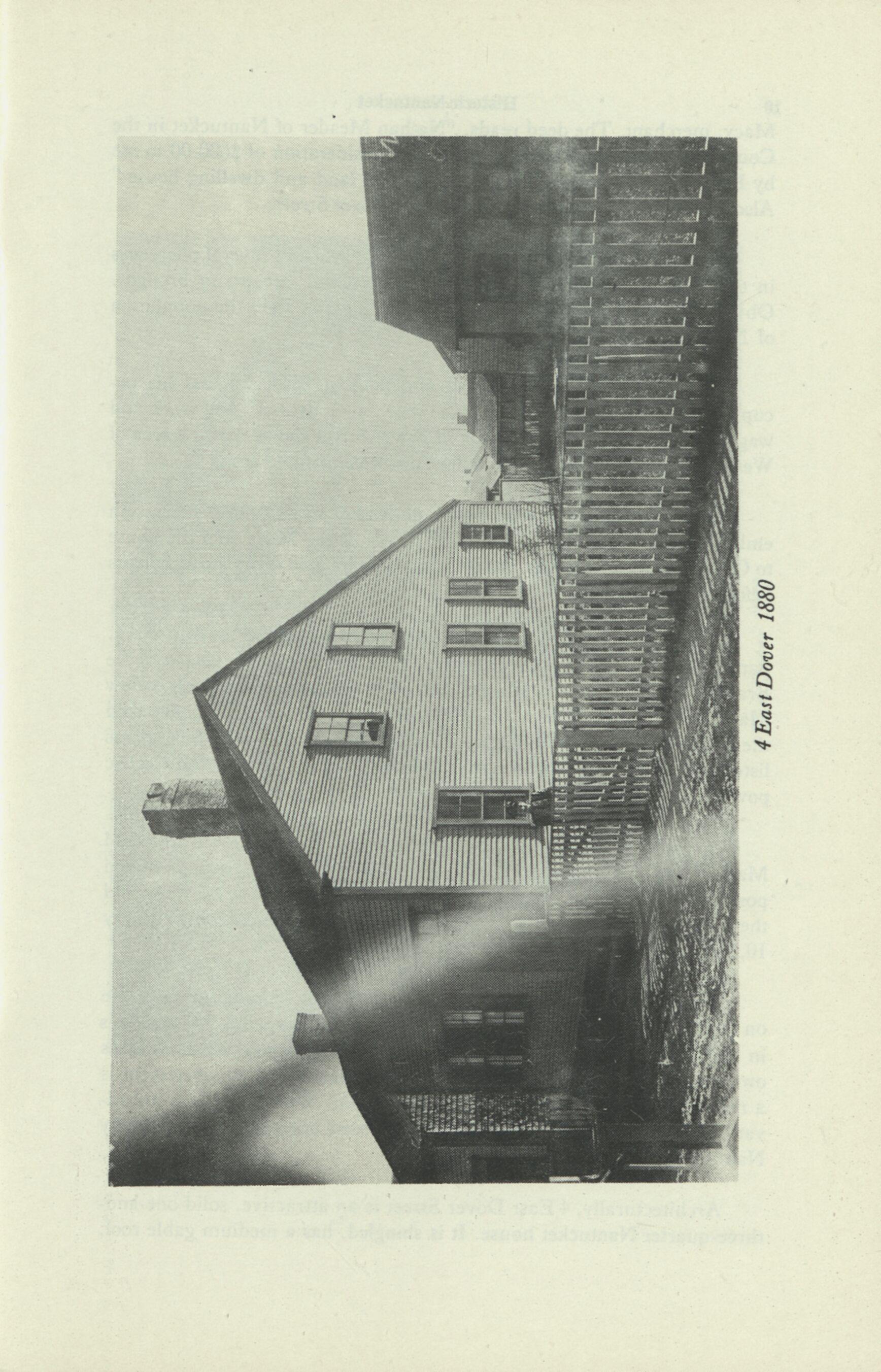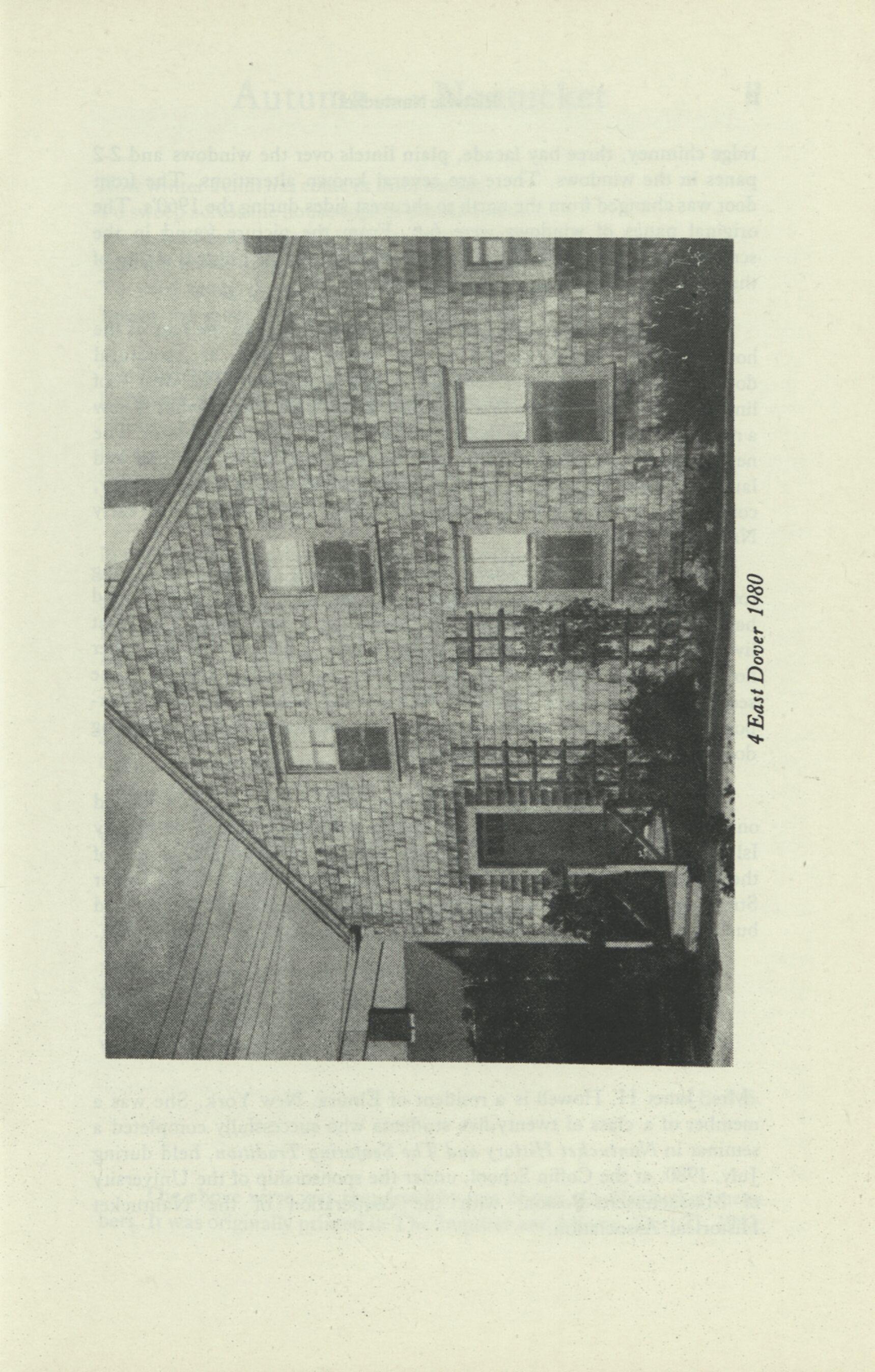
10 minute read
by Jane H. Howell
6 A n H i st ori c a l a n d A r c h ite c tu r a l S u rv e y o f 4 E a st D o v er S t r e e t
By Janet H. Howell
There were progressive events that were significant in the development of the present town of Nantucket and subsequently the building of the house at 4 East Dover Street. When the original settlers arrived on the Island of Nantucket, they homesteaded west and southwest of the present town. Expecting to earn their living farming and raising sheep, it soon became apparent that they must seek another livelihood to sustain the succeeding generations. The sea was the obvious answer and as early as 1678, the proprietors laid out the'Wesco Lots, in an area bounded by Liberty Street, Broad Street, Federal Street, and just beyond Westminister Street in the present town of Nantucket. The new community was to be, and did become a planned community of progressive growth.
In 1716, Joseph Coffin was granted permission to build a wharf. The next year, 1717, the original harbor used by the first settlers, Capaum Pond, proving inadequate, provided the impetus to transfer all activity to the great natural harbor of Nantucket. The same year the land, below Main Street to the south, was divided into house lots. They were called Fish Lots and were immediately built upon, extending from Pine Street eastward to Quanato Bank, or the edge of the cliff between Orange and Union Streets. Fair Street divided this into two parcels, which significantly numbered 27. Three years later, 1720, the official site of Sherborn was moved to the present town of Nantucket.
The next significant development of the town's growth was the construction of Straight Wharf by Richard Macy in 1723. By 1726, two new residential areas were protected. The first was West Monomoy, south of Fish Lots, and the second, South Monomoy, remained as meadowland.
The dwelling of 4 East Dover Street is located in the area known as West Monomoy. This area is divided into two districts, totaling again and significantly, 27 parcels. The name Dover existed at thetime ofthe Isaac Coffin Survey, 1799. Dover Street proper is a short section between Orange and Union Streets. The longer stretch, extending from Orange to Pleasant Street is now called West Dover Street. This area known as
West Monomoy includes (between Pleasant and Orange Streets) the streets of Silver, West Dover, York, Warren, Back, Williams, Cherry, and Bear Streets. Between Orange and Union Streets, it includes the streets of Mulberry, Weymouth, East Dover, East York, Coon, Beaver, and Spring.
Apparently, it was not until the 1820's that East Dover Street had a house built on it, coinciding with the growth of the whaling industry and the town's population.
In my search of deeds for the house and then for the land, it is my understanding that the land where the house, 4 East Dover Street, stands, was originally part of land granted to Thomas Mayhew. In Book 2, page 20, the deed reads,
"To all Christian people or others - William Vaugn of Portsmouth in the county of Dover and Plymouth in the colony of
Massachusetts in New England merchant sendeth greetings know yee that where I the said V augn have lately bought of
Richard Way of Boston and Bethiah his wife a certain purchase of land at the Island of Nantucket and have that twentieth part of said Island belonging to T nomas Mayhew of
Martha's Vineyard .... do constitute my trusted and beloved friend - Nathanial Waer of Hampton my true and lawful attorney agent and substitute in my place for me and in my name and for my wife .... May 20, 1678."
Seventy-five years later, December 18, 1753, John Coleman, descendent of the original proprietor, Thomas Coleman, transfers property to his son John Coleman with mention in the deed that he acquired the land formerly belonging to William Vaugn.

"John Coleman, County of Nantucket in the province of Massachusetts Bay in New England - yoeman - sends greetings know ye that the said John Coleman as well for the love and affection I bear unto him by son John Coleman and to his heirs and assigns forever one sixteenth part of one share of land upon the Island of Nantucket according to the common acceptance of shares of land upon the Island which I bought which was formerly William Vaugn's ... of that land laid out on the west side of the meadows of Monomoy."
This area would be West Monomoy, a residential area that was laid out in 1723.
8 Historic Nantucket
The next transaction of land occurred on. October 15, 1790. John Coleman, and his wife Ann Trott Coleman, transferred land to Essex Boston.
"Know all men - that I John Coleman of Sherborn in the County of Nantucket in the Commonwealth of Massachusetts yoeman and Ann Coleman my wife. For consideration of the sum of 7 pounds 16 shillings lawful money paid me by Essex Boston, shoemaker - a certain tract or piece of land lying and being in Sherborn - at a place called Newtown."
There are three interesting aspects of this deed. The first, that Massachusetts is now a commonwealth, the second, that the British currency is still in use even though the Revolutionary War is over, and thirdly, that Sherborn and Newtown are used as names for the present town of Nantucket.
On April 28, 1821, Essex Boston, a man of colour, sold land to the Gorhams, Davis and John, in consideration of 51 dollars and 34 cents.
This deed clearly tells us that Essex Boston was a Negro, that the currency is changed from British sterling to U.S. dollars, and that there is no mention of Sherborn but of Newtown and New Guiney. Henry Barnard Worth refers to New Guiney as "the Negro town or village south and east of the wind mills near the house of Hezekiah Russell. Angola Street (now called Angora Street) is in the region and the Bostons and the Painters were colored families."

John and Davis Gorham were house carpenters and co-partners in business under the name of John and Davis Gorham. A logical assumption can be made that they bought the land to develop the area. However, on April 25, 1831, the land was transferred to Peleg Macy Jr., merchant", for sixty-six dollars and fifty cents. In this deed the parcel of land was located in Newtown, with no mention of New Guiney.
Three years later, May 17, 1834, Peleg Macy Jr., sold this land to Nathan Meader for $160.00. Land was clearly beginning to appreciate as the whaling industry expanded and prospered.
Nathan Meader was a carpenter and it was within the period of his ownership, May 17, 1834 - June 24, 1844, that the present house known as 4 East Dover Street was built. It is possible that Nathan Meader built it himself. Meader resold the land and the "dwelling house" back to Peleg

10 Historic Nantucket
Macy, merchant. The deed reads, "Nathan Meader of Nantucket in the County of Nantucket, ship carpenter - in consideration of $600.00 to me by Peleg Macy, merchant - a certain tract of land and dwelling house." Also within this deed is the first mention of Dover Street.
The whaling industry was close to its pinnacle and several references in the deed reflect the changes that the economic prosperity brought. Obviously more houses were needed and built for in 1840 the population of Nantucket was 9712.
When Meader sold the house and land in 1844, he lists his occupation as a ship carpenter. Skilled labor was in demand and work and wages generous. With the mention of Dover Street shows that the area of West Monomoy was beginning to develop into a planned area.
When Nantucket whaling began to decline an economic depression embraced the Island. On February 19, 1857, Peleg Macy sold the house to George Allen for $400.00, $200.00 less than he paid for it thirteen years before.
On March 20, 1873, George Allen sold the house to Andrew J. Sandsbury. Sandsbury is listed in the 1897 Directory as the keeper of the , Brandt Point Light. Ownership of the house was transferred to his widow Martha Sandsbury, March 13, 1902, and in October 13, 1902, she sold the house to Liotine A. Souza. In the 1909 Directory, Mr. Souza was listed as a fireman for the gas works. In 1914, a fireman for the electric power house and in 1927 as a carpenter.

On January 28, 1946, the property was transferred to Frank and Mary Hardy. Mr. Hardy worked on the IsLand steamers, then appointed postmaster, and is now employed by the Marine Home Center. They sold the property to Arthur and Patricia Menard on Nantucket on February 10, 1954. He was employed by the Nantucket Electric Co.
The present owners, Rodger and Myrna Butler, purchased the house on September 28, 1970. They are from Westfield, Massachusetts and he is in the insurance business. They are the first off-island owners. This ownership of many Nantucket houses by off-islanders as an investment is a reflection of the current economic conditions. Whether this is an advantage or a dilemma for the Island is the present crisis to be addressed by Nantucketers.
Architecturally, 4 East Dover Street is an attractive, solid one-andthree-quarter Nantucket house. It is shingled, has a medium gable roof,

ridge chimney, three bay facade, plain lintels over the windows and 2-2 panes in the windows. There are several known alterations. The front door was changed from the north to the west sides during the 1960's. The original panes of windows were 6-6. From the picture found in the scrapbooks at the Peter Foulger Museum Library, the original siding of the house was clapboard, and it is now shingle.
The most obvious alteration are the two additions to the rear of the house. Visual documentation of the house as well as structural documentation of the cellar substantiate the alterations. The west roof line was interrupted by the first extension to the rear, adding what is now a modern kitchen. The east roof line is the original line of the house. The next addition was a one story extension that is used as a back hall and laundry room. Both additions reflect the need for more contemporary, comfortable living and the great versatility and adaptability of the early Nantucket homes.
The interior of 4 East Dover Street is charming. There are two living rooms, each with a fireplace, a downstairs bed-room, large kitchen and bath, front hall with single stairs leading to the second story. The front living room and stairs have wide floor boards. I believe that the other floors also have wide floor boards beneath the present flooring. The second story has three bedrooms with sloping ceilings and wide floorboards, one fireplace and a bathroom. All bedrooms have connecting doors. All the doors have lights and lift latches.

The house is modest but well constructed and cozy. It is surrounded on all sides by historic houses that are well maintained and owned by Island people. There is a large lot to the west of the house that is part of the property and a fenced in dog kennel in the rear. A fence borders Dover Street and the yard is well maintained and landscaped with flowers and bushes compatible with the history and the environment of Nantucket.
Mrs. Janet H. Howell is a resident of Elmira, New York. She was a member of a class of twenty-five students who successfully completed a seminar in Nantucket History and The Seafaring Tradition, held during July, 1980, at the Coffin School, under the sponsorship of the University of Massachusetts-Boston, with the cooperation of the Nantucket Historical Association.




